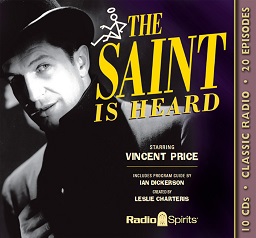
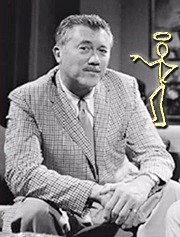 The Saint (1945, 1947-51) aired “The Saint Goes Underground” first on December 17, 1947, and then on July 31, 1949. It is this 1949 rebroadcast that we showcase here. We have run only eight previous episodes of this fine show, this episode being only the 4th since November of 2019 and the 2nd in nearly two years. For new listeners I borrow freely from past episodes’ opening remarks as they deal with the creator and partial history of The Saint on radio, in print, and on film. It is estimated there were in the neighborhood of 157 unique (i.e., original) episodes (depending on which historian you talk to) of which approximately 57 are in circulation.
The Saint (1945, 1947-51) aired “The Saint Goes Underground” first on December 17, 1947, and then on July 31, 1949. It is this 1949 rebroadcast that we showcase here. We have run only eight previous episodes of this fine show, this episode being only the 4th since November of 2019 and the 2nd in nearly two years. For new listeners I borrow freely from past episodes’ opening remarks as they deal with the creator and partial history of The Saint on radio, in print, and on film. It is estimated there were in the neighborhood of 157 unique (i.e., original) episodes (depending on which historian you talk to) of which approximately 57 are in circulation.
Crime and mystery novelist Leslie Charteris’ (photo top right, 1907-1993) famous detective Simon Templar was dubbed The Saint by the underworld, though he was hardly what the monicker implied. The story goes that he came by the name because of his initials, S. T.. The Saint, as a radio show (there were movies, TV shows, novels, and even comic books), ran first in 1945, and then from 1947-1951, with almost all episodes featuring the incomparable Vincent Price (photo lower right, 1911-1993). Before Price assumed the role of The Saint, there were two others before him, beginning with the 1945 run: Edgar Barrier (January-March 1945) and Brian Aherne (June-September 1945). With the rare episode where actor Barry Sullivan would fill in, Vincent Price was the voice of The Saint from July 9, 1947 through May 20, 1951. The final 22 episodes after Price departed saw actor Tom Conway as The Saint, from May 27, 1951 through October 21, 1951.
The first Saint novel was published in 1928 when Charteris was just shy of his 21st birthday and was titled Meet the Tiger. In later years Charteris practically disowned the novel, remarking that it was so poorly written he wondered how it ever got published. Instead, he preferred to count 1930’s second Saint novel Enter the Saint as the first true Saint novel. Be that as it may, he would write Simon Templar  adventures (novels, short stories, and novellas) off and on for the next 33 years, the final Saint book written solely by himself being a collection of stories in 1963 titled The Saint in the Sun. Thereafter, all of the Saint titles would be ghost-written but credited to Charteris, who remained in an editorial capacity, reading the manuscripts and editing where necessary. Of interest to science fiction readers is that the first of the ghost-written Saint novels was written by none other than Harry Harrison (1925-2012, SFWA Grand Master 2009, photo at left), and was 1964’s Vendetta for the Saint. Harrison, also an illustrator early in his career (the legendary Wally Wood would ink Harrison’s pencils for several SF comics, among them Weird Fantasy and Weird Science), also wrote the syndicated The Saint comic strip.
adventures (novels, short stories, and novellas) off and on for the next 33 years, the final Saint book written solely by himself being a collection of stories in 1963 titled The Saint in the Sun. Thereafter, all of the Saint titles would be ghost-written but credited to Charteris, who remained in an editorial capacity, reading the manuscripts and editing where necessary. Of interest to science fiction readers is that the first of the ghost-written Saint novels was written by none other than Harry Harrison (1925-2012, SFWA Grand Master 2009, photo at left), and was 1964’s Vendetta for the Saint. Harrison, also an illustrator early in his career (the legendary Wally Wood would ink Harrison’s pencils for several SF comics, among them Weird Fantasy and Weird Science), also wrote the syndicated The Saint comic strip.
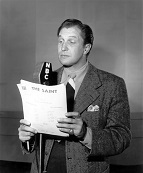
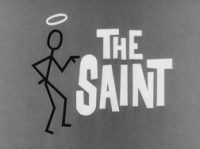 Simon Templar falls into the camp of the “soft-boiled” detective, in line with such as Nero Wolfe, Sherlock Holmes, and Dashiell Hammett’s Nick Charles (who prefer solving crimes with their wits rather than their fists), as opposed to the “hard-boiled” branch of the detective tree and the likes of Sam Spade, Philip Marlowe, and Boston Blackie. The iconic stick figure with halo representing The Saint was first introduced in the early stories as a calling card Templar would leave so that his enemies would know who was responsible for their downfall. The title card/logo above was used in the 1960’s The Saint TV series starring future James Bond star Roger Moore. The TV series originated in the UK and ran from 1962-69, but was picked up by NBC in America and ran as a summer replacement in 1966.
Simon Templar falls into the camp of the “soft-boiled” detective, in line with such as Nero Wolfe, Sherlock Holmes, and Dashiell Hammett’s Nick Charles (who prefer solving crimes with their wits rather than their fists), as opposed to the “hard-boiled” branch of the detective tree and the likes of Sam Spade, Philip Marlowe, and Boston Blackie. The iconic stick figure with halo representing The Saint was first introduced in the early stories as a calling card Templar would leave so that his enemies would know who was responsible for their downfall. The title card/logo above was used in the 1960’s The Saint TV series starring future James Bond star Roger Moore. The TV series originated in the UK and ran from 1962-69, but was picked up by NBC in America and ran as a summer replacement in 1966.
On American radio, however, Vincent Price was the undisputed, one and only Simon Templar, The Saint. His velvety voice and witty banter embodied the proto-typical suave, bon vivant hero/detective, though in a number of episodes the sexual innuendos written for not only his lines, but those of other characters were a bit too risque and obvious for the perceived audience in the late 1940s, though The Saint‘s legion of fans didn’t seem to care.
“The Saint Goes Underground” begins in the air, definitely above ground, as the small chartered plane Simon Templar has hired needs to set down for a maintenance check…at night. The pilot tells Templar there is nothing to worry about and they should be back in the air in a few hours. When Templar asks where they are to land, the pilot replies that the small town just below, Headstone, New Mexico, has an emergency landing strip just the other side of what appears to be a traveling carnival, lit as one would expect with many colorful lights. Hungry, and with several hours to kill, Templar finds the only cab (or rather it finds him) in Headstone, whose driver takes him to the Silver Dollar Hotel and its fine restaurant. After finishing his meal and looking up, Templar finds a beautiful blonde introducing herself to him. She knows of him from the cabbie who has recognized Templar as the Saint, the cabbie’s talent for gossip making any big city cabbie proud, much less one in a place like Headstone. In short, the pretty young woman seeks Simon’s help, as there is an east coast gangster type come to town recently who has threatened her. It turns out she holds the title to a long dead silver mine, bequeathed to her upon the recent death of her father, but which is now worth nothing. Yet, the bent nose type is almost to the point of making her an offer she can’t refuse if she continues to hold out and not sell the worthless mine. At the mercy of a beautiful young woman begging for his help, Simon, more readily than he cares to admit, agrees, and this decision begins the search for the real reason the interest of the mob has been piqued enough to send one of its goons to some godforsaken town in the middle of the desert named Headstone, at some expense and trouble, all because of a worthless mine. We’ve all become aware of the time-proven police observation that there is no such thing as a “routine” traffic stop where simply pulling a car over for an apparent minor infraction can lead to almost anything. This episode of the Saint reinforces the truth of that warning and makes the point once again that for one such as the Saint, even the most innocuous little stop at a small desert town and a quick late-night bite of dinner can lead to quite an adventure, and why, in this tale “The Saint Goes Underground.”
(The CD linked at top includes this episode and 19 others, all digitally remastered.)
Play Time: 24:32
{Airing on a Sunday evening the last day of July in 1949, the neighborhood gang could hardly wait for school to end the following day and then head immediately to the nearby newsstand, this week hoping to find some new detective pulps to complement the Saint episode from the night before. All-Story Detective (1949-51), while showing early promise, lasted but 15 total issues, the final 9 issues renamed 15 Story Detective. History reveals that its major claim to fame were the stories of John D. MacDonald, with the majority of others were print-worthy but unremarkable. It was a bi-monthly in 1949. F.B.I. Detective Stories (1949-51), even with well-written fare, lasted but 14 issues, mostly due to the fact that the time had come when the public was no longer infatuated with stories about the Feds, having had their fill for almost 20 years of their exploits in movies, radio, and print (both novels and magazines). FBI Detective Stories was a bi-monthly in 1949. Two Complete Detective Books (1939-54) was an early precursor to the soon to be popular book clubs. With 2 novels for a quarter it was a deal hard to pass up and accounted in large part to its 76-issue run over its 16-year life span, half of which was spent as a quarterly and half as a bi-monthly, which it was in 1949.}
[Left: All-Story Detective, 8/49 – Center: FBI Detective, 8/49 – Right: Two Complete Det. Books, 7/49]
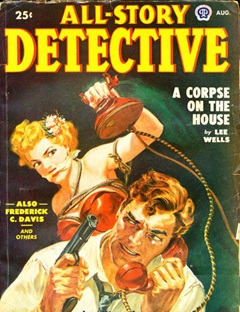
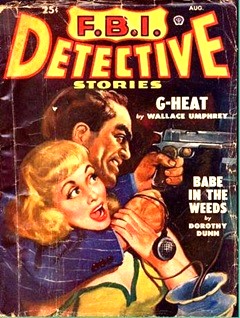
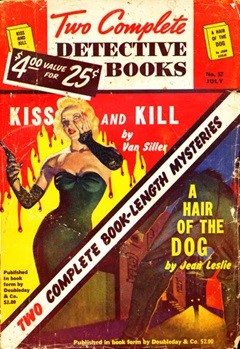
To view the entire list of weekly Old Time Radio episodes at Tangent Online, click here.